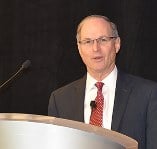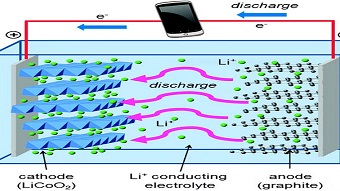"Call to Arms" Issued for Electric Grid Resiliency
David Wagman | September 20, 2017A conference hosted by PJM Interconnection, operator of the nation's largest electric grid, heard a "call to arms" issued by a former Homeland Defense official who cited threats to the electric grid in the face of increasing cyber threats.
"We're facing an increasingly severe international environment," said Paul Stockton, former Assistant Secretary of Defense for Homeland Defense and America's Security Affairs, who described a landscape of emerging physical and cyber threats. "That's all the more reason to care about resilience and, most importantly, build practical steps to strengthen resilience."
 Paul Stockton. Source: PJM InterconnectionStockton spoke at PJM's Grid 20/20: Focus on Security & Resilience conference on September 19. The conference's goal was to facilitate discussion among electric industry leaders on the role of resilience in securing the nation's electric grid.
Paul Stockton. Source: PJM InterconnectionStockton spoke at PJM's Grid 20/20: Focus on Security & Resilience conference on September 19. The conference's goal was to facilitate discussion among electric industry leaders on the role of resilience in securing the nation's electric grid.
"We used to talk about equipment failure and outages caused by storms," said PJM CEO and President Andrew L. Ott. "Now, the threat profile has changed, the considerations are broader. There could be intentional attacks – cyber or physical. Those concerns lead us beyond reliability and into resilience."
For PJM, Ott said, resilience is the ability of the grid to withstand or bounce back quickly from all events that pose additional operational risks. These risks range from extreme weather to earthquakes, cyber and physical attacks, and events not yet imagined.
Experts representing state governors, transmission companies, regulators, government agencies, and others shared best practices in resilience and deliberated the risks and costs involved.
On one discussion panel, government, military, industry and regulatory speakers emphasized the importance of relationship-building in forming public/private bulwarks against the threat of cyberattacks.
Bill Lawrence, senior director of Electricity Information Sharing and Analysis Center for the North American Electric Reliability Corp., offered a positive note on information sharing.
"We have much better internal dialogue going on," Lawrence said. "We're not resting easy, but we're not one mouse-click away from the grid going off."
"We want to assure stakeholders, we are placing more emphasis on actions to take now," said Ott, PJM's CEO. "This is not something that will be solved overnight."
In his keynote remarks, Stockton said: “We need a deeper understanding of the nature of grid resilience and of what it’s going to take to strengthen that resilience against increasing severe threats.”
He listed three challenges for PJM and its stakeholders.
First, a strong set of “conservative operations” needs to be developed in preparation for potential cyberattacks. In addition, the thresholds that would trigger their use must be clearly articulated. That may be tricky, however, as cyber threats often are not as obvious as a hurricane headed toward coastal areas.
“What’s the equivalent to getting ready for cyberattacks, and when would you know to implement?” Stockton asked. The U.S. needs to be ready to “raise the cyber walls,” Stockton said, even to the degree of being prepared to halt market operations.
Second, Stockton urged PJM and stakeholders to prepare for information warfare with adversaries potentially including Russia and China.
“We can count on Russia or other major adversaries conducting false social media campaigns,” he said. “They’re always going to have a political goal for attacking us.”
He noted that, while the Electricity Subsector Coordinating Council provided excellent public communications during the recent hurricanes, false messaging propagated on social media led to overwhelming, unnecessary calls to 911 and panic in otherwise safe areas such as storm shelters. And those reports weren’t even necessarily orchestrated with the intent of disrupting restoration operations.
Third, he said, PJM and its stakeholders must prepare for what he called the unprecedented involvement of government officials in grid operations during perceived emergencies.
The FAST (Fixing America’s Surface Transportation) Act gives Energy Secretary Rick Perry "far-reaching powers to issue emergency orders to do whatever he thinks is necessary to protect or restore the bulk power system,” he said.
With that in mind, industry leaders need to step up and help the Department of Energy figure out what such orders would look like and what would best sustain and restore the grid.




